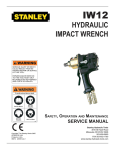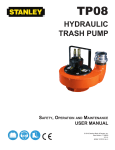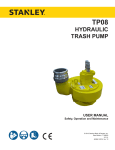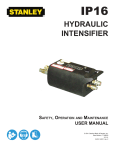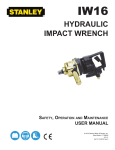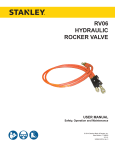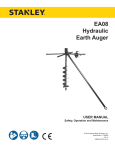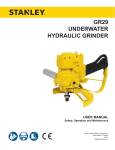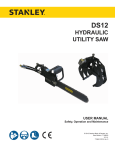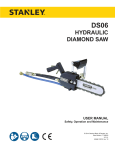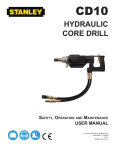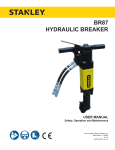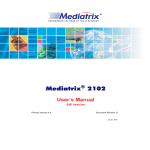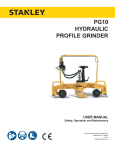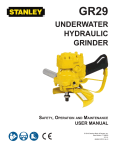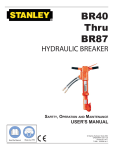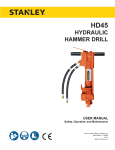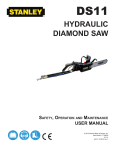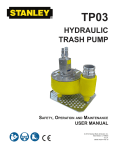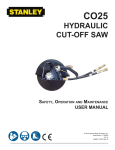Download HYDRAULIC IMPACT WRENCH - Stanley Hydraulic Tools
Transcript
IW12 HYDRAULIC IMPACT WRENCH Safety, Operation and Maintenance USER MANUAL © 2012 Stanley Black & Decker, Inc. New Britain, CT 06053 U.S.A. 66023 9/2013 Ver. 8 DECLARATION OF CONFORMITY DECLARATION OF CONFORMITY ÜBEREINSTIMMUNGS-ERKLARUNG DECLARATION DE CONFORMITE CEE DECLARACION DE CONFORMIDAD DICHIARAZIONE DI CONFORMITA Hydraulic Tools ______________________________________________________________________ I, the undersigned: Ich, der Unterzeichnende: Je soussigné: El abajo firmante: lo sottoscritto: Weisbeck, Andy Surname and First names/Familiennname und Vornamen/Nom et prénom/Nombre y apellido/Cognome e nome hereby declare that the equipment specified hereunder: bestätige hiermit, daß erklaren Produkt genannten Werk oder Gerät: déclare que l’équipement visé ci-dessous: Por la presente declaro que el equipo se especifica a continuación: Dichiaro che le apparecchiature specificate di seguito: Hydraulic Hand Held Impact Wrench 1. Category: Kategorie: Catégorie: Categoria: Categoria: 2. Make/Marke/Marque/Marca/Marca 3. Type/Typ/Type/Tipo/Tipo: 4. Serial number of equipment: Seriennummer des Geräts: Numéro de série de l’équipement: Numero de serie del equipo: Matricola dell´attrezzatura: Stanley IW1214001, IW1234001, IW12140AX All Has been manufactured in conformity with Wurde hergestellt in Übereinstimmung mit Est fabriqué conformément Ha sido fabricado de acuerdo con E’ stata costruita in conformitá con Directive/Standards Richtlinie/Standards Directives/Normes Directriz/Los Normas Direttiva/Norme No. Nr Numéro No n. Approved body Prüfung durch Organisme agréé Aprobado Collaudato EN EN ISO EN ISO Machinery Directive 792-6:1994 3744:2009 28662-7:2009 28927-2:2009 2006/42/EC:2006 Self Self Self Self Self 5. Special Provisions: None Spezielle Bestimmungen: Dispositions particulières: Provisiones especiales: Disposizioni speciali: 6. Representative in the Union: Patrick Vervier, Stanley Dubuis 17-19, rue Jules Berthonneau-BP 3406 41034 Blois Cedex, France. Vertreter in der Union/Représentant dans l’union/Representante en la Union/Rappresentante presso l’Unione Done at/Ort/Fait à/Dado en/Fatto a Stanley Hydraulic Tools, Milwaukie, Oregon USA Signature/Unterschrift/Signature/Firma/Firma Position/Position/Fonction/Cargo/Posizione Rev.7 1/5/2011 2 ► IW12 User Manual Engineering Manager Date/Datum/le/Fecha/Data 1-5-11 TABLE OF CONTENTS DECLARATION OF CONFORMITY...........................................................................................................................2 SAFETY SYMBOLS...................................................................................................................................................4 SAFETY PRECAUTIONS...........................................................................................................................................5 TOOL STICKERS & TAGS.........................................................................................................................................6 HOSE TYPES.............................................................................................................................................................7 HOSE RECOMMENDATIONS...................................................................................................................................8 FIGURE 1. TYPICAL HOSE CONNECTIONS........................................................................................................8 HTMA REQUIREMENTS............................................................................................................................................9 OPERATION.............................................................................................................................................................10 TOOL PROTECTION & CARE.................................................................................................................................12 TROUBLESHOOTING.............................................................................................................................................13 SPECIFICATIONS....................................................................................................................................................14 ACCESSORIES.......................................................................................................................................................14 IW12 STD IMPACT MECHANISM ILLUSTRATION.................................................................................................15 STANDARD IMPACT MECHANISM PARTS LIST....................................................................................................16 HEAVY DUTY IMPACT MECHANISM ILLUSTRATION...........................................................................................17 HEAVY DUTY IMPACT MECHANISM PARTS LIST................................................................................................18 STANDARD IMPACT & HEAVY DUTY IMPACT MECHANISMS IN DETAIL........................................................... 19 IMPORTANT To fill out a Product Warranty Recording form, and for information on your warranty, visit Stanleyhydraulic.com and select the Warranty tab. (NOTE: The warranty recording form must be submitted to validate the warranty). SERVICING THE STANLEY HYDRAULIC IMPACT WRENCH. This manual contains safety, operation, and routine maintenance instructions. Stanley Hydraulic Tools recommends that servicing of hydraulic tools, other than routine maintenance, must be performed by an authorized and certified dealer. Please read the following warning. WARNING SERIOUS INJURY OR DEATH COULD RESULT FROM THE IMPROPER REPAIR OR SERVICE OF THIS TOOL. REPAIRS AND / OR SERVICE TO THIS TOOL MUST ONLY BE DONE BY AN AUTHORIZED AND CERTIFIED DEALER. For the nearest authorized and certified dealer, call Stanley Hydraulic Tools at the number listed on the back of this manual and ask for a Customer Service Representative. IW12 User Manual ◄ 3 SAFETY SYMBOLS Safety symbols and signal words, as shown below, are used to emphasize all operator, maintenance and repair actions which, if not strictly followed, could result in a life-threatening situation, bodily injury or damage to equipment. This is the safety alert symbol. It is used to alert you to potential personal injury hazards. Obey all safety messages that follow this symbol to avoid possible injury or death. DANGER This safety alert and signal word indicate an imminently hazardous situation which, if not avoided, will result in death or serious injury. WARNING This safety alert and signal word indicate a potentially hazardous situation which, if not avoided, could result in death or serious injury. CAUTION This safety alert and signal word indicate a potentially hazardous situation which, if not avoided, could result in death or serious injury. CAUTION This signal word indicates a potentially hazardous situation which, if not avoided, may result in property damage. NOTICE This signal word indicates a situation which, if not avoided, will result in damage to the equipment. IMPORTANT This signal word indicates a situation which, if not avoided, may result in damage to the equipment. Always observe safety symbols. They are included for your safety and for the protection of the tool. LOCAL SAFETY REGULATIONS Enter any local safety regulations here. Keep these instructions in an area accessible to the operator and maintenance personnel. 4 ► IW12 User Manual SAFETY PRECAUTIONS Tool operators and maintenance personnel must always comply with the safety precautions given in this manual and on the stickers and tags attached to the tool and hose. These safety precautions are given for your safety. Review them carefully before operating the tool and before performing general maintenance or repairs. Supervising personnel should develop additional precautions relating to the specific work area and local safety regulations. If so, place the added precautions in the space provided on in this manual. The model IW12 Hydraulic Impact Wrench will provide safe and dependable service if operated in accordance with the instructions given in this manual. Read and understand this manual and any stickers and tags attached to the tool and hose before operation. Failure to do so could result in personal injury or equipment damage. 140 °F/60 °C. Operation at higher temperatures can cause higher than normal temperatures at the tool which can result in operator discomfort. • Do not operate a damaged, improperly adjusted, or incompletely assembled impact wrench. • Never wear loose clothing that can get entangled in the working parts of the tool. • Keep all parts of your body away from the rotating parts. Long hair or loose clothing can become drawn into rotating components. • Always use accessories that conform to the specifications given in the OPERATION section of this manual. • Do not reverse impact wrench rotation direction by changing fluid flow direction. • Release the trigger if the power supply has been interrupted. • When working near electrical conductors, always assume that all conductors are energized and that insulation, clothing and hoses can conduct electricity. Use hose labeled and certified as non-conductive. • The operator must start in a work area without bystanders. Flying debris can cause serious injury. • • Do not operate the tool unless thoroughly trained or under the supervision of an instructor. Establish a training program for all operators to ensure safe operation. To avoid personal injury or equipment damage, all tool repair, maintenance and service must only be performed by authorized and properly trained personnel. • Serious injury or death could result from a tool or accessories dropped from an elevated height. • Warning: Hydraulic fluid under pressure could cause skin injection injury. If you are injured by hydraulic fluid, get medical attention immediately. • During operation do not contact the impact mechanism, accessories or hardware as they can become very hot; use your (PPE) Personal Protection Equipment. • Warning: Use of this tool on certain materials during demolition could generate dust potentially containing a variety of hazardous substances such as asbestos, silica or lead. Inhalation of dust containing these or other hazardous substances could result in serious injury, cancer or death. Protect yourself and those around you. Research and understand the materials you are cutting. Follow correct safety procedures and comply with all applicable national, state or provisional health and safety regulations relating to them, including, if appropriate arranging for the safe disposal of the materials by a qualified person. • Always wear safety equipment such as goggles, gloves, ear, head and breathing protection, and safety shoes at all times when operating the tool. Use gloves and aprons when necessary. • Inspect tool daily for loose fasteners, missing parts and leakage. Have tool repaired if necessary. • The operator must be familiar with all prohibited work areas such as excessive slopes and dangerous terrain conditions. • Maintain proper footing and balance at all times and do not overreach. • Do not inspect or clean the tool while the hydraulic power source is connected. Accidental engagement of the tool can cause serious injury. Be observant of hydraulic and water hose lying about the work area, as they can be a tripping hazard. • Always connect hoses to the tool hose couplers before energizing the hydraulic power source. Be sure all hose connections are tight and are in good condition. • Do not operate the tool at oil temperatures above IW12 User Manual ◄ 5 TOOL STICKERS & TAGS DANGER Failure to use hydraulic hose labeled and certified as non-conductive when using hydraulic tools on or near electric lines may result in death or serious injury. For proper and safe operation read owners manual 25610 RAILROAD HELP DESK DECAL and mwke sure that you have been properly ELECTROCUTION HAZARD trained in correct procedures required for work on or around electric lines. 29083 ROTATION DIRECTION DECAL 12412 DANGER DECAL D Lwa 4-12 GPM / 15-45 LPM DO NOT EXCEED 2000 PSI / 140 BAR DO NOT EXCEED SPECIFIED FLOW OR PRESSURE USE CLOSED-CENTER TOOL ON CLOSED-CENTER SYSTEM. USE OPEN-CENTER TOOL ON OPEN-CENTER SYSTEM. CORRECTLY CONNECT HOSES TO TOOL ‘IN’ AND ‘OUT’ PORTS. IMPROPER HANDLING,USE OR OTHER MAINTENANCE OF TOOL COULD RESULT IN A LEAK OR BURST OR OTHER TOOL FAILURE. CONTACT AT A LEAK OR BURST CAN CAUSE OIL INJECTION INTO THE BODY. FAILURE TO OBSERVE THESE PRECAUTIONS CAN RESULT IN SERIOUS PERSONAL INJURY. 30 LPM @ 138 B AR EHTMA CATEGORY 28322 CE DECAL (CE) 28788 Manual Sticker 11207 CIRCUIT TYPE D DECAL (CE) 29530 SOUND POWER LEVEL DECAL (CE) 03788 GPM DECAL Stanley Hydraulic Tools 3810 SE Naef Road Milwaukie, Oregon USA DANGER Failure to use hydraulic hose labeled and certied as non-conductive when using hydraulic tools on or near electric lines may result in death or serious injury. For proper and safe operation read owners manual and make sure that you have been properly trained in correct procedures required for work on or around ELECTROCUTION electric lines. HAZARD 4-12 GPM / 15-45 LPM DO NOT EXCEED 2000 PSI / 149 BAR ◘ DO NOT EXCEED SPECIFIED FLOW OR PRESSURE ◘ USE CLOSED-CENTER TOOL ON CLOSED-CENTER SYSTEM. ◘ USE OPEN-CENTER TOOL ON OPEN-CENTER SYSTEM. ◘ CORRECTLY CONNECT HOSE TO TOOL “IN” AND “OUT” PORTS. IMPROPER HANDLING, USE OR MAINTENANCE OF TOOL COULD RESULT IN A LEAK, BURST OR OTHER TOOL FAILURE. ◘ CONTACT AT A LEAK OR BURST CAN CAUSE OIL INJECTIONS INTO THE BODY. ◘ FAILURE TO OBSERVE THESE PRECAUTIONS CAN RESULT IN SERIOUS PERSONAL INJURY. Model No. IW12 08012 IW12 NAME TAG (US & CE) 17275 GPM/PRESSURE DANGER DECAL NOTE: THE INFORMATION LISTED ON THE STICKERS SHOWN, MUST BE LEGIBLE AT ALL TIMES. REPLACE DECALS IF THEY BECOME WORN OR DAMAGED. REPLACEMENTS ARE AVAILABLE FROM YOUR LOCAL STANLEY DISTRIBUTOR. D A N G E R 1. FAILURE TO USE HYDRAULIC HOSE LABELED AND CERTIFIED AS NON-CONDUCTIVE WHEN USING HYDRAULIC TOOLS ON OR NEAR ELECTRICAL LINES MAY RESULT IN DEATH OR SERIOUS INJURY. BEFORE USING HOSE LABELED AND CERTIFIED AS NONCONDUCTIVE ON OR NEAR ELECTRIC LINES BE SURE THE HOSE IS MAINTAINED AS NON-CONDUCTIVE. THE HOSE SHOULD BE REGULARLY TESTED FOR ELECTRIC CURRENT LEAKAGE IN ACCORDANCE WITH YOUR SAFETY DEPARTMENT INSTRUCTIONS. 2. A HYDRAULIC LEAK OR BURST MAY CAUSE OIL INJECTION INTO THE BODY OR CAUSE OTHER SEVERE PERSONAL INJURY. A. DO NOT EXCEED SPECIFIED FLOW AND PRESSURE FOR THIS TOOL. EXCESS FLOW OR PRESSURE MAY CAUSE A LEAK OR BURST. B. DO NOT EXCEED RATED WORKING PRESSURE OF HYDRAULIC HOSE USED WITH THIS TOOL. EXCESS PRESSURE MAY CAUSE A LEAK OR BURST. C. CHECK TOOL HOSE COUPLERS AND CONNECTORS DAILY FOR LEAKS. DO NOT FEEL FOR LEAKS WITH YOUR HANDS. CONTACT WITH A LEAK MAY RESULT IN SEVERE PERSONAL INJURY. The safety tag (P/N 15875) at right is attached to the tool when shipped from the factory. Read and understand the safety instructions listed on this tag before removal. We suggest you retain this tag and attach it to the tool when not in use. 15-45 LPM / 4-12 GPM 140 BAR / 2000 PSI D A N G E R D. DO NOT LIFT OR CARRY TOOL BY THE HOSES. DO NOT ABUSE HOSE. DO NOT USE KINKED, TORN OR DAMAGED HOSE. 3. MAKE SURE HYDRAULIC HOSES ARE PROPERLY CONNECTED TO THE TOOL BEFORE PRESSURING SYSTEM. SYSTEM PRESSURE HOSE MUST ALWAYS BE CONNECTED TO TOOL “IN” PORT. SYSTEM RETURN HOSE MUST ALWAYS BE CONNECTED TO TOOL “OUT” PORT. REVERSING CONNECTIONS MAY CAUSE REVERSE TOOL OPERATION WHICH CAN RESULT IN SEVERE PERSONAL INJURY. 4. DO NOT CONNECT OPEN-CENTER TOOLS TO CLOSEDCENTER HYDRAULIC SYSTEMS. THIS MAY RESULT IN LOSS OF OTHER HYDRAULIC FUNCTIONS POWERED BY THE SAME SYSTEM AND/OR SEVERE PERSONAL INJURY. 5. BYSTANDERS MAY BE INJURED IN YOUR WORK AREA. KEEP BYSTANDERS CLEAR OF YOUR WORK AREA. 6. WEAR HEARING, EYE, FOOT, HAND AND HEAD PROTECTION. 7. TO AVOID PERSONAL INJURY OR EQUIPMENT DAMAGE, ALL TOOL REPAIR MAINTENANCE AND SERVICE MUST ONLY BE PERFORMED BY AUTHORIZED AND PROPERLY TRAINED PERSONNEL. I M P O R T A N T I M P O R T A N T READ OPERATION MANUAL AND SAFETY INSTRUCTIONS FOR THIS TOOL BEFORE USING IT. READ OPERATION MANUAL AND SAFETY INSTRUCTIONS FOR THIS TOOL BEFORE USING IT. USE ONLY PARTS AND REPAIR PROCEDURES APPROVED BY STANLEY AND DESCRIBED IN THE OPERATION MANUAL. USE ONLY PARTS AND REPAIR PROCEDURES APPROVED BY STANLEY AND DESCRIBED IN THE OPERATION MANUAL. TAG TO BE REMOVED ONLY BY TOOL OPERATOR. TAG TO BE REMOVED ONLY BY TOOL OPERATOR. SEE OTHER SIDE SEE OTHER SIDE SAFETY TAG P/N 15875 (Shown smaller then actual size) 6 ► IW12 User Manual HOSE TYPES The rated working pressure of the hydraulic hose must be equal to or higher than the relief valve setting on the hydraulic system. There are three types of hydraulic hose that meet this requirement and are authorized for use with Stanley Hydraulic Tools. They are: Certified non-conductive — constructed of thermoplastic or synthetic rubber inner tube, synthetic fiber braid reinforcement, and weather resistant thermoplastic or synthetic rubber cover. Hose labeled certified nonconductive is the only hose authorized for use near electrical conductors. Wire-braided (conductive) — constructed of synthetic rubber inner tube, single or double wire braid reinforcement, and weather resistant synthetic rubber cover. This hose is conductive and must never be used near electrical conductors. Fabric-braided (not certified or labeled non-conductive) — constructed of thermoplastic or synthetic rubber inner tube, synthetic fiber braid reinforcement, and weather resistant thermoplastic or synthetic rubber cover. This hose is not certified non-conductive and must never be used near electrical conductors. HOSE SAFETY TAGS To help ensure your safety, the following DANGER tags are attached to all hose purchased from Stanley Hydraulic Tools. DO NOT REMOVE THESE TAGS. If the information on a tag is illegible because of wear or damage, replace the tag immediately. A new tag may be obtained from your Stanley Distributor. D A N G E R D A N G E R 1. FAILURE TO USE HYDRAULIC HOSE LABELED AND CERTIFIED AS NON-CONDUCTIVE WHEN USING HYDRAULIC TOOLS ON OR NEAR ELECTRIC LINES MAY RESULT IN DEATH OR SERIOUS INJURY. FOR PROPER AND SAFE OPERATION MAKE SURE THAT YOU HAVE BEEN PROPERLY TRAINED IN CORRECT PROCEDURES REQUIRED FOR WORK ON OR AROUND ELECTRIC LINES. 2. BEFORE USING HYDRAULIC HOSE LABELED AND CERTIFIED AS NON-CONDUCTIVE ON OR NEAR ELECTRIC LINES. WIPE THE ENTIRE LENGTH OF THE HOSE AND FITTING WITH A CLEAN DRY ABSORBENT CLOTH TO REMOVE DIRT AND MOISTURE AND TEST HOSE FOR MAXIMUM ALLOWABLE CURRENT LEAKAGE IN ACCORDANCE WITH SAFETY DEPARTMENT INSTRUCTIONS. 3. DO NOT EXCEED HOSE WORKING PRESSURE OR ABUSE HOSE. IMPROPER USE OR HANDLING OF HOSE COULD RESULT IN BURST OR OTHER HOSE FAILURE. KEEP HOSE AS FAR AWAY AS POSSIBLE FROM BODY AND DO NOT PERMIT DIRECT CONTACT DURING USE. CONTACT AT THE BURST CAN CAUSE BODILY INJECTION AND SEVERE PERSONAL INJURY. 4. HANDLE AND ROUTE HOSE CAREFULLY TO AVOID KINKING, ABRASION, CUTTING, OR CONTACT WITH HIGH TEMPERATURE SURFACES. DO NOT USE IF KINKED. DO NOT USE HOSE TO PULL OR LIFT TOOLS, POWER UNITS, ETC. 5. CHECK ENTIRE HOSE FOR CUTS CRACKS LEAKS ABRASIONS, BULGES, OR DAMAGE TO COUPLINGS IF ANY OF THESE CONDITIONS EXIST, REPLACE THE HOSE IMMEDIATELY. NEVER USE TAPE OR ANY DEVICE TO ATTEMPT TO MEND THE HOSE. 6. AFTER EACH USE STORE IN A CLEAN DRY AREA. SEE OTHER SIDE SIDE 1 SEE OTHER SIDE (Shown smaller than actual size) DO NOT REMOVE THIS TAG DO NOT REMOVE THIS TAG THE TAG SHOWN BELOW IS ATTACHED TO “CERTIFIED NON-CONDUCTIVE” HOSE SIDE 2 D A N G E R D A N G E R 1. DO NOT USE THIS HYDRAULIC HOSE ON OR NEAR ELECTRIC LINES. THIS HOSE IS NOT LABELED OR CERTIFIED AS NON-CONDUCTIVE. USING THIS HOSE ON OR NEAR ELECTRICAL LINES MAY RESULT IN DEATH OR SERIOUS INJURY. 5. CHECK ENTIRE HOSE FOR CUTS CRACKS LEAKS ABRASIONS, BULGES, OR DAMAGE TO COUPLINGS IF ANY OF THESE CONDITIONS EXIST, REPLACE THE HOSE IMMEDIATELY. NEVER USE TAPE OR ANY DEVICE TO ATTEMPT TO MEND THE HOSE. 2. FOR PROPER AND SAFE OPERATION MAKE SURE THAT YOU HAVE BEEN PROPERLY TRAINED IN CORRECT PROCEDURES REQUIRED FOR WORK ON OR AROUND ELECTRIC LINES. 6. AFTER EACH USE STORE IN A CLEAN DRY AREA. 3. DO NOT EXCEED HOSE WORKING PRESSURE OR ABUSE HOSE. IMPROPER USE OR HANDLING OF HOSE COULD RESULT IN BURST OR OTHER HOSE FAILURE. KEEP HOSE AS FAR AWAY AS POSSIBLE FROM BODY AND DO NOT PERMIT DIRECT CONTACT DURING USE. CONTACT AT THE BURST CAN CAUSE BODILY INJECTION AND SEVERE PERSONAL INJURY. 4. HANDLE AND ROUTE HOSE CAREFULLY TO AVOID KINKING, CUTTING, OR CONTACT WITH HIGH TEMPERATURE SURFACES. DO NOT USE IF KINKED. DO NOT USE HOSE TO PULL OR LIFT TOOLS, POWER UNITS, ETC. DO NOT REMOVE THIS TAG DO NOT REMOVE THIS TAG THE TAG SHOWN BELOW IS ATTACHED TO “CONDUCTIVE” HOSE. SEE OTHER SIDE SEE OTHER SIDE SIDE 1 SIDE 2 (Shown smaller than actual size) IW12 User Manual ◄ 7 8 ► IW12 User Manual All hydraulic hose must meet or exceed specifications as set forth by SAE J517. All hydraulic hose must have at least a rated minimum working pressure equal to the maximum hydraulic system relief valve setting. This chart is intended to be used for hydraulic tool applications only based on Stanley Hydraulic Tools tool operating requirements and should not be used for any other applications. The chart to the right shows recommended minimum hose diameters for various hose lengths based on gallons per minute (gpm)/ liters per minute (lpm). These recommendations are intended to keep return line pressure (back pressure) to a minimum acceptable level to ensure maximum tool performance. Tool to Hydraulic Circuit Hose Recommendations 15-34 MM Inside Diameter INCH USE (Press/Return) PSI up to 10 up to 3 3/8 10 Both 2250 49-60 13-16 FLOW >>> RETURN <<< FLOW PRESSURE 26-100 up to 25 100-200 51-100 up to 50 100-300 51-100 up to 50 26-100 up to 25 8-30 up to 8 30-60 15-30 up to 15 30-90 15-30 up to 15 7.5-30 up to 7.5 Figure 1. Typical Hose Connections 49-60 38-49 10-13 13-16 19-40 5-10.5 38-49 19-40 5-10.5 10-13 19-40 5-10.5 38-49 15-23 10-13 15-23 4-6 19 25.4 16 19 19 25.4 5/8 3/4 3/4 1 19 3/4 1 16 3/4 16 19 3/4 5/8 16 5/8 5/8 16 13 13 10 5/8 1/2 1/2 3/8 Return Pressure Return Pressure Return Pressure Return Pressure Both Return Pressure Both Both Both Both 2500 2500 2500 2500 2500 2500 2500 2500 2500 2500 2500 2500 2500 2500 2500 175 175 175 175 175 175 175 175 175 175 175 175 175 175 175 155 BAR Min. Working Pressure Certified Non-Conductive Hose - Fiber Braid - for Utility Bucket Trucks METERS Hose Lengths FEET Conductive Hose - Wire Braid or Fiber Braid -DO NOT USE NEAR ELECTRICAL CONDUCTORS 4-6 4-9 LPM Oil Flow GPM HOSE RECOMMENDATIONS HTMA REQUIREMENTS HTMA / EHTMA REQUIREMENTS HTMA HYDRAULIC SYSTEM REQUIREMENTS TYPE I Nominal Operating Pressure (at the power supply outlet) 4-6 gpm (15-23 lpm) 1500 psi (103 bar) TOOL TYPE TYPE II TYPE RR 7-9 gpm (26-34 lpm) 1500 psi (103 bar) 9-10.5 gpm (34-40 lpm) 1500 psi (103 bar) System relief valve setting (at the power supply outlet) 2100-2250 psi (145-155 bar) 2100-2250 psi (145-155 bar) 2200-2300 psi (152-159 bar) 2100-2250 psi (145-155 bar) Maximum back pressure (at tool end of the return hose) 250 psi (17 bar) 250 psi (17 bar) 250 psi (17 bar) 250 psi (17 bar) Measured at a max. fluid viscosity of: (at min. operating temperature) 400 ssu* 400 ssu* 400 ssu* 400 ssu* (82 centistokes) (82 centistokes) (82 centistokes) (82 centistokes) Temperature: Sufficient heat rejection capacity to limit max. fluid temperature to: (at max. expected ambient temperature) 140° F (60° C) Flow Range 140° F (60° C) 140° F (60° C) TYPE III 11-13 gpm (42-49 lpm) 1500 psi (103 bar) 140° F (60° C) 3 hp 5 hp 6 hp 7 hp Min. cooling capacity at a temperature (2.24 kW) (3.73 kW) (5.22 kW) (4.47 kW) difference of between ambient and fluid 40° F 40° F 40° F 40° F temps (22° C) (22° C) (22° C) (22° C) NOTE: Do not operate the tool at oil temperatures above 140° F (60° C). Operation at higher temperatures can cause operator discomfort at the tool. Filter Min. full-flow filtration Sized for flow of at least: (For cold temp. startup and max. dirt-holding capacity) 25 microns 30 gpm (114 lpm) Hydraulic fluid Petroleum based (premium grade, anti-wear, non-conductive) Viscosity (at min. and max. operating temps) 100-400 ssu* 25 microns 30 gpm (114 lpm) 25 microns 30 gpm (114 lpm) 100-400 ssu* 100-400 ssu* (20-82 centistokes) 25 microns 30 gpm (114 lpm) 100-400 ssu* NOTE: When choosing hydraulic fluid, the expected oil temperature extremes that will be experienced in service determine the most suitable temperature viscosity characteristics. Hydraulic fluids with a viscosity index over 140 will meet the requirements over a wide range of operating temperatures. *SSU = Saybolt Seconds Universal EHTMA HYDRAULIC SYSTEM REQUIREMENTS CLASSIFICATION B C D Nominal Operating Pressure (at the power supply outlet) 3.5-4.3 gpm (13.5-16.5 lpm) 1870 psi (129 bar) 4.7-5.8 gpm (18-22 lpm) 1500 psi (103 bar) 7.1-8.7 gpm (27-33 lpm) 1500 psi (103 bar) 9.5-11.6 gpm (36-44 lpm) 1500 psi (103 bar) 11.8-14.5 gpm (45-55 lpm) 1500 psi (103 bar) System relief valve setting (at the power supply outlet) 2495 psi (172 bar) 2000 psi (138 bar) 2000 psi (138 bar) 2000 psi (138 bar) 2000 psi (138 bar) Flow Range NOTE: These are general hydraulic system requirements. See tool specification page for tool specific requirements IW12 User Manual ◄ 9 OPERATION WRENCH TORQUE INFORMATION FACTORS THAT AFFECT TORQUE An impact wrench is a rotary hammer that impacts the head of a bolt or nut. It does not apply a slow steady torque as a standard torque wrench. Therefore, several factors affect the result of torque when using impact wrenches: 1. LONG BOLTS. Long bolts having high-friction threads with lubrication under the bolt head or associated nut can twist when impacted, then untwist before the next impact. This will especially happen if there is low friction between the bolt head or nut and the mating surface. 2. HEAVY, LOOSE OR MULTIPLE ADAPTERS. Heavy, loose or multiple adapters between the wrench and socket can dissipate the intensity of the impact to the bolt head or nut. 3. AMOUNT OF IMPACT. Maximum torque results can be obtained by allowing continuous impacting of the socket against the bolt head or nut for at least 10 seconds. 4. HYDRAULIC FLOW RATE. If the flow rate to the tool is too low, the hammer (or impact) speed is reduced. If the flow is correct, a change in the relief pressure does not affect the impact force. Poorly designed hydraulic circuits can result in lower flow rates and reduced impact speeds when pressure is required during impacting. BOLT GRADE AND THREAD RECOMMENDATIONS Allowable bolt torque is limited by both bolt thread diameter and grade of steel in the bolt. The IW12 Impact Wrench is recommended for use on the following bolt grade and thread sizes: SAE Grade 2 1 to 1-1/2 inch / 25/38 mm SAE Grade 5 3/4 to 1-1/4 inch / 19-32 mm SAE Grade 8 5/8 to 1 inch / 16-25 mm PREOPERATION PROCEDURES CHECK POWER SOURCE 1. Using a calibrated flow meter and pressure gauge, check that the hydraulic power source develops a flow of 4–12 gpm/15-45 lpm at 1000–2000 psi/70140 bar. 2. Make certain that the hydraulic power source is equipped with a relief valve set to open at 2100 psi/145 bar minimum. 10 ► IW12 User Manual CONNECT HOSES 1. Wipe all hose couplers with a clean, lint-free cloth before making connections. 2. Connect hoses from the hydraulic power source to the tool fittings or quick disconnects. It is good practice to connect the return hose first and disconnect it last to minimize or eliminate trapped pressure within the wrench. WARNING Always use sockets and accessories designed for impact type applications. DO NOT USE STANDARD SOCKETS OR ACCESSORIES. THESE CAN CRACK OR FRACTURE DURING OPERATION. 3. Observe the flow indicators stamped on the main body assembly and the hose couplers to ensure that the flow is in the proper directions. The female couple on the tools “IN” port is the inlet (pressure) coupler. NOTE: If the uncoupled hoses are left in the sun, pressure increase within the hoses can make them difficult to connect. Whenever possible, connect the free ends of hoses together. WRENCH OPERATION The IW12 is designed for 3/4-inch square sockets and accessories. Adapter part number 06790 or equivalent will permit the use of 5/8-inch quick change drive attachments. Normal applications include installation or removal of fasteners requiring torque in the range of 300–1200 ft lb/407–1627 Nm and auger bit wood boring. DO NOT use the wrench as a hammer drill for metal drilling. During normal operation it is common to see some grease leakage from around the anvil during hard use. Refer to the IW12 Service Manual for the correct lubrication procedures. 1. Observe all Safety Precautions. 2. Move the hydraulic circuit control valve to the “ON” position to operate the wrench. OPERATION 3. Select the direction of impact desired using the rotary reversing valve located on the left side of the wrench. To select clockwise direction, move the lever toward the front (drive end) of the wrench. To select counterclockwise direction, move the lever to the rear (handle end) of the wrench. NOTE: To more accurately tighten bolts, lubricate threads, check with a torque wrench and duplicate time of impacting for other bolts of the same length and thread size. POST OPERATION UNDERWATER MODELS ONLY The wrench impact mechanism must be cleaned and greased with waterproof grease after every day of use. The main housing valve and motor are sealed and do not require maintenance unless they are malfunctioning. Remove, clean, grease and assemble the impact mechanism as described in the IW12 Service Manual. 4. Squeeze the trigger to activate the wrench. 5. Release the trigger to stop the wrench. COLD WEATHER OPERATION If the wrench is to be used during cold weather, preheat the hydraulic fluid at low engine speed. When using the normally recommended fluids, fluid temperature should be at or above 50°F/10 °C (400 ssu/82 centistokes) before use. Damage to the hydraulic system or wrench can result from use with fluid that is too viscous or too thick. IW12 User Manual ◄ 11 TOOL PROTECTION & CARE NOTICE In addition to the Safety Precautions found in this manual, observe the following for equipment protection and care. • Make sure all couplers are wiped clean before connection. • The hydraulic circuit control valve must be in the “OFF” position when coupling or uncoupling hydraulic tools. Failure to do so may result in damage to the quick couplers and cause overheating of the hydraulic system. • Do not exceed the rated flow (see Specifications) in this manual for correct flow rate and model number. Rapid failure of the internal seals may result. • Always keep critical tool markings, such as warning stickers and tags legible. • Tool repair should be performed by experienced personnel only. • Always store the tool in a clean dry space, safe from damage or pilferage. • • Make sure the circuit PRESSURE hose (with male quick disconnect) is connected to the “IN” port. The circuit RETURN hose (with female quick disconnect) is connected to the opposite port. Do not reverse circuit flow. This can cause damage to internal seals. Make certain that the recommended relief valves are installed in the pressure side of the system. • Do not use the tool for applications for which it was not intended. • Always replace hoses, couplings and other parts with replacement parts recommended by Stanley Hydraulic Tools. Supply hoses must have a minimum working pressure rating of 2500 psi/172 bar. 12 ► IW12 User Manual TROUBLESHOOTING If symptoms of poor performance develop, the following chart can be used as a guide to correct the problem. When diagnosing faults in operation of the wrench, always check that the hydraulic power source is supplying the correct hydraulic flow and pressure to the tool as listed in the following table. Use a flow meter known to be accurate. Check the flow with the hydraulic fluid temperature at least 80 °F/27 °C. PROBLEM Low performance or impact. CAUSE SOLUTION Incorrect hydraulic flow. Check that the hydraulic power source is producing 4–12 gpm/15–45 lpm at 1000–2000 psi/70–140 bar. Defective quick disconnects. Check each quick disconnect. Worn impact mechanism. Repair or replace the impact mechanism. See Service Mechanism Removal Cleaning and Installation procedure to extend mechanism life. Hammer pins broken. Replace with integral frame (with pins). Check relief adjustment screw setting. Job may require a larger wrench. Incorrect grease or periodic maintenance of the impact mechanism is not being performed. See Service Manual. Spools incorrectly installed. Valve(s) incorrectly reassembled. See Service Manual. Sockets or adapters too heavy or loose. Use the correct impact type sockets or adapters. Long bolt with lubricated head. Lubricate threads only. Incorrect hydraulic flow (too high). Check that hydraulic power source is producing 4-12 gpm/15-45 lpm at 1000-2000 psi/70-140 bar. Supply and return hoses reversed. Install hoses correctly. Refer to Operation section in this manual. Relief sleeve or spring damaged. Remove and replace spool assembly. Adjusting screw is in too far. Adjust correctly. Grease leaks at anvil busing, wrench warm. Hard duty cycle and heat forces grease out. Normal unless greasing instructions in Service Manual are not followed. Grease leaks at anvil bushing, wrench cold. Main shaft O-ring leaking. Replace as required. Oil leak at motor cap face. Fasteners loose. Tighten to recommended torque. Face O-ring worn or missing. Replace as required. Motor cap/main housing damaged. Replace as required. Damaged O-rings. Replace as required. Check Service Manual to avoid cutting O-rings on cross holes in the spool bore. Wrong hydraulic fluid. Circuit too hot. Refer to Operation section for correct fluid/circuit specifications. Wrench runs too fast. Impact mechanism or screws broken. Oil leaks at reversing spool. IW12 User Manual ◄ 13 SPECIFICATIONS Drive Size.................................................................................... 3/4-inch Square Drive, 5/8-inch Hex Quick Change Weight.........................................................................................................................................................14 lbs/6 kg Overall Length................................................................................................................................... 9-1/2-inch/24 cm Width....................................................................................................................................................... 4-inch/10 cm Pressure Range.................................................................................................................1000-2000 psi/70–140 bar Flow Range................................................................................................................................ 4–12 gpm/15–45 lpm Optimum Flow............................................................................................................................ 5–10 gpm/20–38 lpm System Type......................................................................................... Open and Closed Center, HTMA Type II or III Porting.....................................................................................................................................................8 SAE O-ring Output Speed (free spin)....................................................................................................2000 rpm at 5 gpm/19 lpm Input Speed.......................................................................................................................... 1200 Impacts per Minute Connect Size and Type.....................................................................................................3/8-inch Male Pipe Adapter Torque...........................................................................................................................250–1200 ft. lb/340–1632 Nm SOUND AND VIBRATION DECLARATION Test conducted on 1212140, S/N 121610100 operated at standard 10 gpm input Measured A-weighted sound power level, Lwa (ref. 1pW) in decibels Uncertainty, Kwa, in decibels Measured A-weighted sound pressure level, Lpa (ref. 20 µPa) at operator’s position, in decibels Uncertainty, Kpa, in decibels 108 dBA 3 dBA 95 dBA 3 dBA Values determined according to noise test code given in ISO 15744, using the basic standard ISO 3744 NOTE: The sum of a measured noise emission value and its associated uncertainty represents an upper boundary of the range of values which is likely to occur in measurements. Declared vibration emission value in accordance with EN 12096 Measured vibration emission value (Main Handle): a Uncertainty: K Measured vibration emission value (Assist Handle): a Uncertainty: K 10.9 m/sec² 1.2 m/sec² 11.2 m/sec² 1.2 m/sec² Values determined according to ISO 28927-2, ISO 5349-1,2 ACCESSORIES Description Part Number 3/4-inch Square Anvil to 3/4-inch Jacobs Chuck................................................................................................01857 7/16-inch Hex Shank × 1/2-inch Square Male Adapter...................................................................................... 05117 5/8-inch Hex Shank × 1/2-inch Square Male Adapter........................................................................................05080 3/4-inch Square Anvil to 5/8-inch Hex Quick Change Adapter...........................................................................06790 AUGER DRILL BITS – LINEMAN’S STYLE 5/8-inch Hex Shank use with Hex Adapter 06790 5/8 Hex Pole Bit, 9/16 × 18 × 22 Overall Length................................................................................................27845 5/8 Hex Pole Bit, 13/16 × 18 × 22 Overall Length..............................................................................................27847 Assist Handle Kit................................................................................................................................................71706 14 ► IW12 User Manual PARTS LIST IW12 STD IMPACT MECHANISM ILLUSTRATION 55 55 CLEAN, APPLY 242 LOCTITE®, AND TORQUE (8) CAPSCREWS TO 28–30 FT LB / 37.9–40.6 NM USING THE TORQUE PATTERN SHOWN AT THE RIGHT Adapter Part Number 06790, used to adapt 3/4-inch Square Drive to 5/8-inch Hex Quick Change. Adapter P/N 01857, used to adapt 3/4-inch Square Drive to 3/4-inch 3-Jaw Jacobs Chuck. IW12 User Manual ◄ 15 PARTS LIST STANDARD IMPACT MECHANISM PARTS LIST ITEM NO. PART NO. QTY DESCRIPTION 1 07999 1 MAIN HOUSING ASSY – INCL ITEM 3 ALSO INCL BALL STOP 19454 AND STEEL BALL 51185 NOT PICTURED ITEM NO. PART NO. QTY DESCRIPTION 32 01459 8 LOCKWASHER, 3/8 00812 8 LOCKWASHER, 3/8, (STAINLESS STEEL, UNDERWATER) 33 08023 1 O-RING * 34 07980 1 PILOT RING 35 08017 1 O-RING * 36 09396 1 BACK-UP RING * 37 07987 1 BACK-UP WASHER 38 00166 1 RETAINING RING 39 08019 2 THRUST RACE 40 08020 1 THRUST BEARING 41 22064 1 ROD WIPER (UNDERWATER) * 42 02685 4 CAPSCREW, 5/16-18 × 7/8 HEX SOCKET HD 01870 4 CAPSCREW, 3/8-16 × 1-3/4 HEX SOCKET HD (STAINLESS STEEL, UNDERWATER) 43 12287 1 CAPSCREW, 10-24 × 1 HEX SOCKET HD (STAINLESS STEEL, UNDERWATER) 3 08014 2 DU BUSHING – GARLOCK 14DU12 4 07988 1 SPRING 5 07982 1 SPRING REST 6 07985 1 SPRING 7 07993 1 RELIEF POPPET 8 07986 1 RELIEF SEAT 9 73046 1 VALVE SPOOL 10 00145 4 LOCKWASHER, 5/16-IN. 00231 4 LOCKWASHER, 5/16-IN. (STAINLESS STEEL) 11 06533 1 O-RING * 12 22063 1 SPOOL CAP (UNDERWATER) 13 00026 1 O-RING * 14 23678 1 HEADED PUSH PIN (UNDERWATER) 15 07996 1 TRIGGER 12283 1 TRIGGER (UNDERWATER) 28536 1 TRIGGER (CE) 44 08067 1 HAMMER 00025 1 CAPSCREW, 10-24 × 1-3/4 HEX SOCKET HD 45 19456 1 HAMMER FRAME ASSY – INCL HAMMER PINS 00786 1 CAPSCREW, 10-24 × 1-3/4 HEX SOCKET HD (STAINLESS STEEL) 46 12285 1 TRIGGER GUARD (UNDERWATER) 17 08002 1 REVERSING SPOOL 47 08070 1 ANVIL – 3/4 IN. SQUARE DRIVE 18 01211 2 O-RING * 08070 1 ANVIL (UNDERWATER) MODEL IW1234001 19 08015 2 BACK-UP RING* 08071 1 HAMMER CASE ASSY – INCL ITEM 49 12785 1 HAMMER CASE ASSY (UNDERWATER) MODEL IW1234001 08072 1 HAMMER CASE BUSHING (LAND) MODEL 13694 1 HAMMER CASE BUSHING (UNDERWATER MODEL) 50 00149 1 O-RING * (LAND & UNDERWATER) 51 00294 1 O-RING * (UNDERWATER) 52 00936 2 ADAPTER, 1/2 SAE TO 3/8 NPT MALE 53 06971 2 LOCKNUT, 10-24 54 03693 1 DECAL, CLOSED-CENTER 55 08069 2 HAMMER PINS (INCLUDED WITH ITEM 45 08073 1 SEAL KIT – LAND MODEL 13695 1 SEAL KIT – UNDERWATER MODEL 16 20 08016 1 RETAINING RING 21 04939 1 LEVER 22 00720 1 SETSCREW, 1/4-20 × 3/8 00580 1 SETSCREW, 1/4-20 × 1/4 (STAINLESS STEEL, UNDERWATER) 23 07997 1 MOTOR CAP ASSY – INCL ITEM 3 24 07989 1 IDLER GEAR ASSY – INCL ITEM 25 25 07978 1 IDLER GEAR BUSHING 26 07991 1 IDLER SHAFT 27 08001 1 MAIN SHAFT 28 00717 1 O-RING * 29 00429 1 NUT, 5/16-18 09277 1 NUT, 5/16-18 (STAINLESS STEEL, UNDERWATER) 30 19453 1 RELIEF ADJUSTMENT SCREW 31 00682 8 CAPSCREW, 3/8-16 × 1-3/4 HEX SOCKET HD (STAINLESS STEEL, UNDERWATER) 01870 8 CAPSCREW, 3/8-16 × 1-3/4 HEX SOCKET HD 16 ► IW12 User Manual 48 49 * Part of Seal Kit PARTS LIST HEAVY DUTY IMPACT MECHANISM ILLUSTRATION CLEAN, APPLY 242 LOCTITE®, AND TORQUE (8) CAPSCREWS TO 28–30 FT LB / 37.9– 40.6 NM USING THE TORQUE PATTERN SHOWN AT THE BOTTOM LEFT IW12 User Manual ◄ 17 PARTS LIST HEAVY DUTY IMPACT MECHANISM PARTS LIST ITEM NO. PART NO. QTY DESCRIPTION 1 07999 1 MAIN HOUSING ASSY(INCL ITEM 3) ALSO INCL BALL STOP 19454 AND STEEL BALL 51185 NOT PICTURED 2 08012 1 NAME TAG 3 08014 2 DU BUSHING – GARLOCK 14DU12 4 07988 1 SPRING 5 07982 1 SPRING REST 6 07985 1 SPRING 7 07993 1 RELIEF POPPET 8 07986 1 RELIEF SEAT 9 73046 1 VALVE SPOOL 10 00145 4 LOCKWASHER, 5/16-IN. 11 06533 1 O-RING * 12 22063 1 SPOOL CAP (UNDERWATER) 13 00026 1 O-RING * 14 23678 1 HEADED PUSH PIN 15 07996 1 TRIGGER 16 00025 1 CAPSCREW, 10-24 × 1-3/4 HEX SOCKET HD 17 08002 1 REVERSING SPOOL 18 01211 2 O-RING * 19 08015 2 BACK-UP RING * 20 08016 1 RETAINING RING 21 04939 1 LEVER 22 00720 1 SETSCREW, 1/4-20 × 3/8 23 07997 1 MOTOR CAP ASSY – INCL ITEM 3 24 07989 1 IDLER GEAR ASSY – INC. ITEM 25 25 07978 1 IDLER GEAR BUSHING 26 07991 1 IDLER SHAFT 27 08001 1 MAIN SHAFT 28 00717 1 O-RING * 29 00429 1 NUT, 5/16-18 30 19453 1 RELIEF ADJUSTMENT SCREW 31 00682 8 CAPSCREW, 3/8-16 × 1-3/4 HEX SOCKET HD (STAINLESS STEEL, UNDERWATER) 32 01459 8 LOCKWASHER, 3/8 33 08023 1 O-RING * 34 22064 1 WIPER * 35 08017 1 O-RING * 36 09396 1 BACK-UP RING * 37 07987 1 BACK-UP WASHER 38 00166 1 RETAINING RING 39 08019 2 THRUST RACE 40 08020 1 THRUST BEARING 18 ► IW12 User Manual ITEM NO. PART NO. QTY DESCRIPTION 41 02685 4 CAPSCREW, 5/16-18 × 7/8 HEX SOCKET HD 42 08067 1 HAMMER 43 20257 1 HAMMER FRAME 44 08069 2 HAMMER PIN 45 22728 1 ANVIL – 3/4 IN. SQUARE DRIVE STANDARD 20263 1 ANVIL – 3/4 IN. SQUARE DRIVE 12-IN. EXTND 29087 1 HAMMER CASE ASSY 22729 1 IMPACT MECHANISM – HEAVY DUTY 20258 1 HAMMER CASE BUSHING (LAND) 35445 1 HAMMER CASE BUSHING (UNDERWATER) 48 00149 1 O-RING (LAND & UNDERWATER) * 49 20262 1 RETAINING RING 50 21408 1 THRUST BEARING RACE 51 09878 1 THRUST BEARING 52 20259 1 RETAINER 53 00936 2 ADAPTER, 1/2 SAE TO 3/8 NPT MALE 54 06971 2 LOCKNUT, 10-24 55 17275 1 DECAL, GPM 56 03693 1 DECAL, CLOSED-CENTER 06345 2 PLASTIC PLUG (NOT ILLUSTRATED) 08073 1 SEAL KIT – LAND MODEL 22729 1 IMPACT MECHANISM – HEAVY DUTY 35451 1 IMPACT MECHANISM – HEAVY DUTY U/W 46 47 * Part of Seal Kit PARTS LIST STANDARD IMPACT & HEAVY DUTY IMPACT MECHANISMS IN DETAIL When ordering Impact Mechanism parts, first determine which mechanism you have by visually inspecting the following two parts indicated by the arrows (A: Hammer Case, B: Anvil). STANDARD MECHANISM 55 A 55 B HEAVY DUTY MECHANISM A Note the difference in the Hammer Case (A) when ordering. B NOTE: The Anvil (B) for a Standard Mechanism has a tab on one end, while the Heavy Duty Anvil has a round diameter on one end. IW12 User Manual ◄ 19 Stanley Hydraulic Tools 3810 SE Naef Road Milwaukie, Oregon 97267-5698 USA (503) 659-5660 / Fax (503) 652-1780 www.stanleyhydraulic.com




















